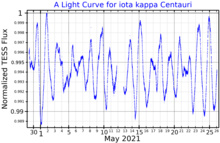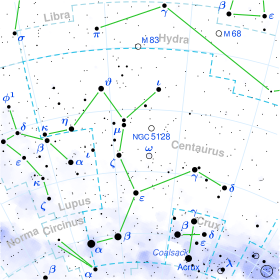Kappa Centauri (κ Cen, κ Centauri) is a binary star in the southern constellation of Centaurus. With an apparent visual magnitude of +3.14,[2] it can be viewed with the naked eye on a dark night. Parallax measurements place it at an estimated distance of 380 light-years (120 parsecs) from Earth.[1]
| Observation data Epoch J2000.0 Equinox J2000.0 | |
|---|---|
| Constellation | Centaurus |
| Right ascension | 14h 59m 09.68494s[1] |
| Declination | −42° 06′ 15.1069″ |
| Apparent magnitude (V) | +3.14[2] |
| Characteristics | |
| Spectral type | B2 IV[3] |
| U−B color index | −0.805[2] |
| B−V color index | −0.204[2] |
| Variable type | Candidate β Cep[4] |
| Astrometry | |
| Radial velocity (Rv) | +8.0[5] km/s |
| Proper motion (μ) | RA: −17.62[1] mas/yr Dec.: −22.51[1] mas/yr |
| Parallax (π) | 8.51 ± 0.54 mas[1] |
| Distance | 380 ± 20 ly (118 ± 7 pc) |
| Absolute magnitude (MV) | –2.2[6] |
| Details | |
| κ Cen A | |
| Mass | 7.2 ± 0.5[3] M☉ |
| Radius | 4.4 ± 0.7[3] R☉ |
| Luminosity | 2,500[3] L☉ |
| Surface gravity (log g) | 4.02 ± 0.20[3] cgs |
| Temperature | 19,800 ± 900[3] K |
| Rotational velocity (v sin i) | 10[7] km/s |
| Age | 18.2 ± 3.2[8] Myr |
| κ Cen B | |
| Mass | 5[9] M☉ |
| Other designations | |
| Database references | |
| SIMBAD | data |
This is a spectroscopic binary system where the presence of an orbiting companion is revealed by shifts in the absorption lines caused by the Doppler effect. The primary component is a huge star, with about seven times the Sun's mass and four times the Sun's radius.[3] It has a stellar classification of B2 IV,[3] indicating that it is in the subgiant stage of its stellar evolution. An effective temperature of 19,800 K[3] in the outer envelope is what gives it the blue-white hue of a B-type star.[11]

The primary is a candidate Beta Cephei variable that shows line-profile variations in its spectrum. However, the nature of the variability remains uncertain because of the binary nature of the system.[4] As of 2007, the secondary component was separated from the primary by 0.128 arcseconds at a position angle of 156°. It has about 68% of the mass of the primary.[9] This system is a proper motion member of the Upper Centaurus–Lupus sub-group in the Scorpius–Centaurus OB association, the nearest such co-moving association of massive stars to the Sun.[6]
In Chinese, 騎官 (Qí Guān), meaning Imperial Guards, refers to an asterism consisting of κ Centauri, γ Lupi, δ Lupi, β Lupi, λ Lupi, ε Lupi, μ Lup, π Lupi, ο Lupi and α Lupi.[13] Consequently, the Chinese name for κ Centauri itself is 騎官三 (Qí Guān sān, English: the Third Star of Imperial Guards.).[14] From this Chinese name, the name Ke Kwan has appeared.[15]
See also
editReferences
edit- ^ a b c d e van Leeuwen, F. (November 2007), "Validation of the new Hipparcos reduction", Astronomy and Astrophysics, 474 (2): 653–664, arXiv:0708.1752, Bibcode:2007A&A...474..653V, doi:10.1051/0004-6361:20078357, S2CID 18759600
- ^ a b c d Gutierrez-Moreno, Adelina; Moreno, Hugo (June 1968), "A Photometric Investigation of the Scorpio-Centaurus Association", Astrophysical Journal Supplement, 15: 459, Bibcode:1968ApJS...15..459G, doi:10.1086/190168
- ^ a b c d e f g h i Hubrig, S.; et al. (January 2009), "New magnetic field measurements of beta Cephei stars and Slowly Pulsating B stars", Astronomische Nachrichten, 330 (4): 317, arXiv:0902.1314, Bibcode:2009AN....330..317H, doi:10.1002/asna.200811187, S2CID 17497112
- ^ a b Schrijvers, C.; Telting, J. H.; De Ridder, J. (2002), "A Spectroscopic Search for Non-Radial Pulsations in Early B-Type Stars", in Aerts, Conny; Bedding, Timothy R.; Christensen-Dalsgaard, Jørgen (eds.), Radial and Nonradial Pulsations as Probes of Stellar Physics, ASP Conference Proceedings, vol. 259, San Francisco: Astronomical Society of the Pacific, p. 204, Bibcode:2002ASPC..259..204S
- ^ Evans, D. S. (June 20–24, 1966), "The Revision of the General Catalogue of Radial Velocities", in Batten, Alan Henry; Heard, John Frederick (eds.), Determination of Radial Velocities and their Applications, Proceedings from IAU Symposium no. 30, University of Toronto: International Astronomical Union, Bibcode:1967IAUS...30...57E
- ^ a b de Geus, E. J.; de Zeeuw, P. T.; Lub, J. (June 1989), "Physical parameters of stars in the Scorpio-Centaurus OB association", Astronomy and Astrophysics, 216 (1–2): 44–61, Bibcode:1989A&A...216...44D
- ^ Bernacca, P. L.; Perinotto, M. (1970). "A catalogue of stellar rotational velocities". Contributi Osservatorio Astronomico di Padova in Asiago. 239 (1). Bibcode:1970CoAsi.239....1B.
- ^ Tetzlaff, N.; Neuhäuser, R.; Hohle, M. M. (January 2011), "A catalogue of young runaway Hipparcos stars within 3 kpc from the Sun", Monthly Notices of the Royal Astronomical Society, 410 (1): 190–200, arXiv:1007.4883, Bibcode:2011MNRAS.410..190T, doi:10.1111/j.1365-2966.2010.17434.x, S2CID 118629873
- ^ a b Kouwenhoven, M. B. N.; et al. (October 2007), "The primordial binary population. II. Recovering the binary population for intermediate mass stars in Scorpius OB2", Astronomy and Astrophysics, 474 (1): 77–104, arXiv:0707.2746, Bibcode:2007A&A...474...77K, doi:10.1051/0004-6361:20077719, S2CID 15750945
- ^ "kap Cen -- Variable Star", SIMBAD, Centre de Données astronomiques de Strasbourg, retrieved 2012-01-23
- ^ "The Colour of Stars", Australia Telescope, Outreach and Education, Commonwealth Scientific and Industrial Research Organisation, December 21, 2004, archived from the original on March 18, 2012, retrieved 2012-01-16
- ^ "MAST: Barbara A. Mikulski Archive for Space Telescopes". Space Telescope Science Institute. Retrieved 1 October 2024.
- ^ (in Chinese) 中國星座神話, written by 陳久金. Published by 台灣書房出版有限公司, 2005, ISBN 978-986-7332-25-7.
- ^ (in Chinese) AEEA (Activities of Exhibition and Education in Astronomy) 天文教育資訊網 2006 年 7 月 25 日 Archived 2011-05-22 at the Wayback Machine
- ^ Richard Hinckley Allen: Star Names — Their Lore and Meaning: Centaurus
